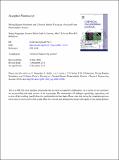Files in this item
Mixing regime simulation and cellulose particle tracing in a Stacked Frame Photocatalytic Reactor
Item metadata
| dc.contributor.author | Nagarajan, Sanjay | |
| dc.contributor.author | Stella, Lorenzo | |
| dc.contributor.author | Lawton, Linda A. | |
| dc.contributor.author | T. S. Irvine, John | |
| dc.contributor.author | Robertson, Peter K. J. | |
| dc.date.accessioned | 2017-12-08T00:32:03Z | |
| dc.date.available | 2017-12-08T00:32:03Z | |
| dc.date.issued | 2017-04-01 | |
| dc.identifier | 248156124 | |
| dc.identifier | 4f961579-c3c4-46b4-8e6c-f409f5b70b52 | |
| dc.identifier | 85007109212 | |
| dc.identifier | 000394723200030 | |
| dc.identifier.citation | Nagarajan , S , Stella , L , Lawton , L A , T. S. Irvine , J & Robertson , P K J 2017 , ' Mixing regime simulation and cellulose particle tracing in a Stacked Frame Photocatalytic Reactor ' , Chemical Engineering Journal , vol. 313 , pp. 301-308 . https://doi.org/10.1016/j.cej.2016.12.016 | en |
| dc.identifier.issn | 1385-8947 | |
| dc.identifier.other | RIS: urn:C149CA4B34E831B47F400FE3D7E893B3 | |
| dc.identifier.other | ORCID: /0000-0002-8394-3359/work/68280601 | |
| dc.identifier.uri | https://hdl.handle.net/10023/12293 | |
| dc.description | This work was supported by the Engineering and Physical Sciences Research Council (Project number EP/K036769/1), Robert Gordon University’s IDEAS PhD studentship and Queen’s University Belfast’s PhD studentship. | en |
| dc.description.abstract | To sustainably meet the global energy demand, unconventional methods to produce renewable energy must emerge. Biofuels from cellulose (via fermentable sugar production) mediated via photocatalysis provides an alternative to conventional fossil fuels. In order to effectively drive photocatalytic processes an effective reactor design is required, the design of which is influenced by a number of key factors such as the catalyst to reactant ratio and residence time, catalyst illumination time, light penetration and distribution for the system, mass transfer limitations (mixing) and product recovery. In this study we use COMSOL Multiphysics® to simulate and assess one of the mentioned parameters – mixing regime of cellulose particles in a Stacked Frame Photocatalysis Reactor (SFPR). In the reactor design, we compare two mixers: a ‘plus’ shaped magnetic stirrer bar and an 8 blade Rushton impeller. The simulations reveal that the Rushton impeller offers a radial mixing pattern with a higher fluid velocity of 1.2 m/s when compared to the stirrer bar that offers a fluid velocity of 0.9 m/s. Cellulose particle tracing simulations confirm that the particle dispersion is superior in the case of the Rushton impeller as the vorticity generated during the mixing push the particles to the reactor’s walls. Since the particles are forced towards the walls, there is a probability of more particles being illuminated than in the case of no or improper mixing. | |
| dc.format.extent | 8 | |
| dc.format.extent | 1711689 | |
| dc.language.iso | eng | |
| dc.relation.ispartof | Chemical Engineering Journal | en |
| dc.subject | Photocatalysis | en |
| dc.subject | COMSOL | en |
| dc.subject | Fermentable Sugars | en |
| dc.subject | Mixing | en |
| dc.subject | Simulation | en |
| dc.subject | QD Chemistry | en |
| dc.subject | NDAS | en |
| dc.subject | SDG 7 - Affordable and Clean Energy | en |
| dc.subject.lcc | QD | en |
| dc.title | Mixing regime simulation and cellulose particle tracing in a Stacked Frame Photocatalytic Reactor | en |
| dc.type | Journal article | en |
| dc.contributor.sponsor | EPSRC | en |
| dc.contributor.institution | University of St Andrews. School of Chemistry | en |
| dc.contributor.institution | University of St Andrews. EaSTCHEM | en |
| dc.identifier.doi | 10.1016/j.cej.2016.12.016 | |
| dc.description.status | Peer reviewed | en |
| dc.date.embargoedUntil | 2017-12-07 | |
| dc.identifier.grantnumber | EP/K036769/1 | en |
This item appears in the following Collection(s)
Items in the St Andrews Research Repository are protected by copyright, with all rights reserved, unless otherwise indicated.

